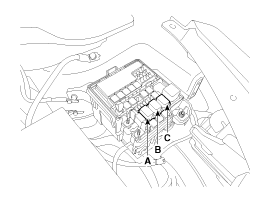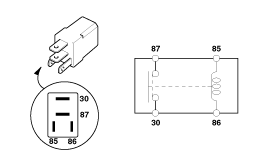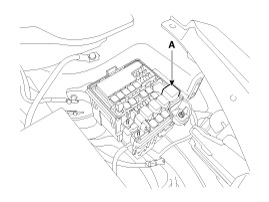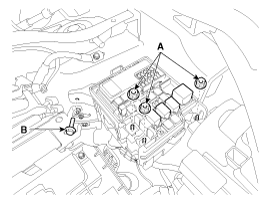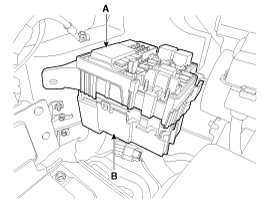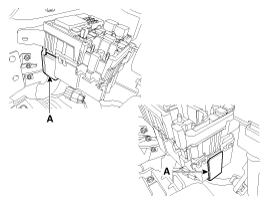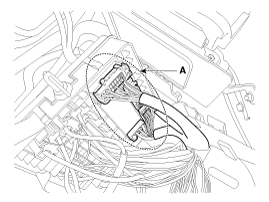Kia Soul EV: Fuses And Relays / Relay Box (Engine Compartment) Repair procedures
Kia Soul EV (PS EV) 2015-2020 Service Manual / Body Electrical System / Fuses And Relays / Relay Box (Engine Compartment) Repair procedures
| Inspection |
| 1. |
Disconnect the negative (-) battery terminal. |
| 2. |
Pull out the relay from the engine compartment relay box. |
Power Relay (Type A)
|
Check for continuity between the terminals.
A : Power outlet relay
B : Cooling fan relay 1
C : Defroster relay
| 1. |
There should be continuity between terminals No.30 and No.87 when power and ground are connected to terminals No.85 and No.86. |
| 2. |
There should be no continuity between terminals No.30 and No.87 when power is disconnected.
|
Power Relay (Type C)
Check for continuity between the terminals.
A : Cooling fan relay 2
| 1. |
There should be continuity between terminals No.30 and No.87 when power and ground are connected to terminals No.85 and No.86. |
| 2. |
There should be no continuity between terminals No.30 and No.87 when power is disconnected.
|
Replacement of EMS box
| 1. |
Disconnect the negative (-) battery terminal. |
| 2. |
Loosen the mounting nuts (A) and bolt (B).
|
| 3. |
Remove the engine room fuse & relay box from the hole (A).
|
| 4. |
Separate the engine room upper box (A) and lower cover (B).
|
| 5. |
Remove the wire cover (A) on the engine room lower box.
|
| 6. |
Disconnect the connectors (A) from the EMS box.
|
Fuse
| 1. |
Be sure that there are no loose fuse holders and that the fuses are held securely. |
| 2. |
Is the fuse capacity correct for each circuit? |
| 3. |
Are there any blown fuses?
If a fuse is to be replaced, be sure to use a new fuse of the
same capacity. At all times, determine the cause of blown fuse and
eliminate the problem before installing a new fuse. |
Multi Fuse

|
 Relay Box (Engine Compartment) Components and Components Location
Relay Box (Engine Compartment) Components and Components Location
Component Location
...
 Relay Box (Passenger Compartment) Components and Components Location
Relay Box (Passenger Compartment) Components and Components Location
Component Location
...
Other information:
Kia Soul EV (PS EV) 2015-2020 Service Manual: Front Stabilizer Bar Repair procedures
Replacement 1. Loosen the wheel nuts slightly. Raise the vehicle, and make sure it is securely supported. 2. Loosen the bolt (A) and then disconnect the universal joint assembly from the pinion of the steering gear box. Tightening torque: 32.4 ~ 37.3N.m (3.3 ~ 3.8kgf.m, 23.9 ~ 27.5lb-f ...
Kia Soul EV (PS EV) 2015-2020 Service Manual: Luggage Side Trim Repair procedures
Replacement • Put on gloves to protect your hands. • When prying with a flat-tip screwdriver, wrap it with protective tape, and apply protective tape around the related parts, to prevent damage. • Us ...
Copyright © www.ksoulev.com 2020-2025



